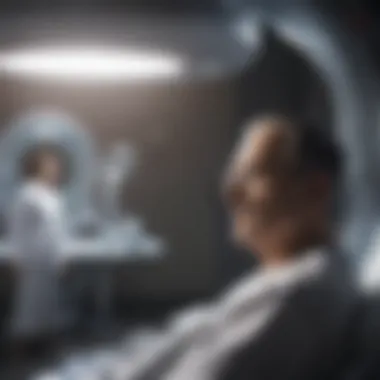Exploring Radiation Treatment Effects on Prostate Cancer


Background and Context
Prostate cancer remains a significant health concern across the globe, necessitating ongoing research and advancements in treatment methodologies. Radiation treatment has emerged as a key modality in combating this form of cancer. It employs high-energy particles or waves to target malfunctioning cells, thereby aiming to eradicate them while preserving surrounding healthy tissue. Understanding the complex dynamics of radiation therapy involves delving into the historical evolution and the advancements in technology that have shaped its current implementation.
In the earlier phases of cancer treatment, practitioners primarily relied on surgery and hormone therapies. However, as research progressed throughout the twentieth century, the incorporation of radiation began to gain traction. It predominantly served as an adjunct to surgery or hormone therapy, but its utility has expanded vastly, with techniques like stereotactic body radiation therapy (SBRT) and intensity-modulated radiation therapy (IMRT) gaining favor due to their precision and reduced side effects.
The significance of understanding radiation therapy’s role in prostate cancer treatment cannot be overstated. As more patients seek knowledge about their treatment options, the integration of historical and current perspectives informs better treatment choices, enhances awareness of potential side effects, and improves the quality of life, all of which are crucial for both patients and their caregivers.
Key Findings and Discussion
Major Results of the Study
Recent studies have underscored that radiation therapy can be an effective treatment for localized prostate cancer. Approximately 70% of patients respond positively to this modality, experiencing remission or stable disease post-treatment. Notably, radiation delivers a targeted effect; advances in technology have continually improved the accuracy with which it can pinpoint tumor locations, thus maximizing cancer cell destruction while minimizing damage to adjacent organs.
Detailed Analysis of Findings
However, it's important to acknowledge that while radiation treatment offers therapeutic advantages, it is not without its drawbacks. The potential side effects, such as urinary incontinence, sexual dysfunction, and gastrointestinal issues, present valid concerns for patients. The onset and severity of these side effects can vary significantly from one individual to another.
"Understanding the balance between the benefits of tumor control and the side effects of treatment can empower patients to make informed decisions regarding their cancer therapy."
Factors Influencing Treatment Outcomes
Several factors can influence the outcomes of radiation therapy for prostate cancer:
- Stage of Cancer: Earlier stages tend to have better outcomes compared to more advanced cases.
- Patient’s Age and Health: Younger patients with fewer comorbidities generally fare better with radiation therapy.
- Technology Used: Modern techniques, such as IMRT and SBRT, can drastically improve patient experience and outcomes.
By synthesizing the intricacies of radiation therapy, patients and caregivers can navigate their options with clarity. The journey through prostate cancer treatment is often marked by uncertainty, but knowledge is a potent ally in making empowered decisions.
Preamble to Prostate Cancer and Radiation Treatment
Understanding the complexities of prostate cancer and the role of radiation treatment is paramount for navigating the journey from diagnosis to recovery. Prostate cancer, like any other malignancy, brings with it a web of concerns for patients and their families. The mere mention of cancer can evoke a plethora of emotions, ranging from fear to hope. That's why the introductory concepts surrounding prostate cancer and its treatment options must be explored thoroughly.
The intersection of prostate cancer and radiation therapy warrants our attention, as it sheds light on the mechanisms through which this treatment modality works, along with its potential impacts on the patient’s health and quality of life. This section aims to anchor the reader in the knowledge required to understand the significance of radiation treatment in managing prostate cancer.
Overview of Prostate Cancer
Prostate cancer is a significant health concern, particularly for men over the age of 50. The prostate is a small gland that plays a crucial role in the male reproductive system, but when cancer cells begin to multiply uncontrollably, the effects can be devastating. According to statistics, one in nine men will be diagnosed with prostate cancer at some point in their lives, making it crucial to dissect this illness and the options available for treatment
- Risk Factors: Various factors increase the likelihood of developing prostate cancer. These include age, family history, and ethnicity.
- Symptoms: Early-stage prostate cancer might not present noticeable symptoms; however, advanced stages could lead to issues like difficulty urinating, blood in urine, or pain in the back, hips, or pelvis. Awareness of these signs can lead to earlier detection, which significantly influences treatment outcomes.
The process of diagnosing prostate cancer often involves a combination of PSA blood tests, digital rectal examinations, and biopsies. Once diagnosed, patients find themselves at a crossroads, weighing the benefits and drawbacks of various treatment options available, and that's where radiation therapy comes to the forefront.
What is Radiation Treatment?
Radiation treatment, or radiotherapy, is a targeted cancer treatment that utilizes high-energy particles or waves to destroy or damage cancer cells. It operates on the principle of damaging the DNA of the cancer cells, rendering them incapable of multiplying and leading to their eventual death. What makes radiation treatment particularly relevant for prostate cancer patients is its ability to precisely target tumor tissues while minimizing damage to surrounding healthy tissues.
- Types of Radiation Treatment: Radiation treatment can be divided primarily into external beam radiation therapy and brachytherapy. External beam therapy administers radiation from outside the body, whereas brachytherapy involves placing radioactive material directly inside or very close to the cancer site.
- Scheduling and Duration: The treatment schedules vary, with some patients undergoing treatment daily for several weeks, depending on their specific health metrics and cancer characteristics.
The technology and methodologies surrounding radiation treatment continue to evolve, bringing about increased efficacy and reduced side effects. This article aims to delve deeper into the impacts of such treatments, sparking informed discussions among patients and healthcare providers.
"Radiation therapy can be a powerful tool in the fight against prostate cancer, but understanding its implications is essential for optimal outcomes."
In summary, the landscape of prostate cancer and its treatment options can be intricate and multifaceted. This introduction sets the stage for further exploration into radiation therapy's mechanisms, effectiveness, and long-term consequences, essential information for those seeking clarity in their treatment pathways.
Mechanisms of Radiation Therapy
Understanding the mechanisms of radiation therapy is critical when delving into its application for prostate cancer treatment. This section will not merely skim the surface; it will peel back the layers to reveal how radiation functions, its different methods, and its overarching significance in combatting this disease. It is essential to grasp these mechanisms to appreciate the treatment's potential benefits and the careful consideration necessary for its application.
Types of Radiation Used
External Beam Radiation Therapy
External Beam Radiation Therapy (EBRT) employs high-energy beams like X-rays or protons, effectively targeting cancerous cells from outside the body. The precision of EBRT is one of its hallmark qualities. This allows healthcare providers to concentrate the radiation dose on tumor areas while minimizing exposure to surrounding healthy tissue.
A significant advantage of EBRT is its non-invasive nature. Patients often prefer this methodology due to the convenience and the lack of any surgical procedure. However, one must also consider that multiple sessions are required for it to be effective, making it a time-consuming option for some. Moreover, there's a risk of skin irritation and fatigue following treatment, which may influence a patient’s overall experience during therapy.
Brachytherapy
Brachytherapy stands out as an innovative strategy in radiation treatment, involving the placement of radioactive sources directly inside or very close to the tumor. This method allows for a high radiation dose targeting prostate tissue while minimizing exposure to adjacent organs. Additionally, the ability to leave the radioactive seeds in place enables continuous treatment over time.
The key characteristic of brachytherapy is its emphasis on localized treatment, making it especially suitable for patients with localized prostate cancer. One unique feature of this technique is that it can often be performed as an outpatient procedure, reducing the need for extensive recovery. Nevertheless, brachytherapy may not be as effective for more advanced disease stages and can lead to urinary symptoms or sexual dysfunction in some patients.
Radiopharmaceuticals


Radiopharmaceuticals represent a fascinating frontier in cancer treatment, involving the administration of radioactive substances that selectively target prostate cancer cells. Typically delivered through intravenous injection or orally, these substances can localize within tumors due to prostate-specific markers.
The leading candidate in this category is Radium-223, known for its capability to treat advanced prostate cancer that has spread to the bones. The specific characteristics of radiopharmaceuticals make them particularly desirable for patients with limited treatment options. However, there are considerations to keep in mind, such as potential systemic side effects and the need for close monitoring after treatment.
How Radiation Affects Cancer Cells
Radiation therapy, regardless of the method, fundamentally alters the behavior of cancer cells. When radiation successfully penetrates the cells, it damages their DNA. This damage can initiate a cascade of events leading to cell death.
Cancer cells are evaluated based on their capacity to repair this DNA damage. If they are unable to do so, they may undergo apoptosis. This mechanism is pivotal in understanding why certain tumor types respond more favorably to radiation than others. Furthermore, the body's immune response can be influenced by radiation, creating an environment that may help to combat residual cancer cells, underscoring the multifaceted nature of radiation therapy in managing prostate cancer.
Effectiveness of Radiation Treatment
Understanding the effectiveness of radiation treatment in the context of prostate cancer is essential for patients and healthcare providers alike. This section will shed light on specific success rates and the factors influencing these outcomes, thereby guiding patient decision-making and therapy planning. The goal here is to demystify the complexities involved and assess the various elements that can impact the effectiveness of this form of treatment.
Success Rates and Factors Influencing Outcomes
Cancer Stage
In the world of oncology, the stage of cancer is often a key determinant of treatment effectiveness. Prostate cancer can range from very localized to widely spread, significantly influencing outcomes. Men diagnosed at an early stage, such as Stage I or II, generally have a higher success rate with radiation therapy compared to those with Stage III or IV, when the disease has advanced. The primary characteristic of these early stages is that the cancer is often still within the prostate, making it more susceptible to targeted treatments. This is beneficial for patients, as they are likely to experience a better prognosis and fewer side effects.
However, as the stage progresses, the effectiveness can wane. In later stages, the cancer may invade surrounding tissues or metastasize, which complicates treatment and diminishes the chance of success. The unique feature here is how early intervention has proven, time and again, to correlate with more favorable outcomes. This emphasizes the importance of regular screening and the need for patients to advocate for timely diagnosis.
Patient Health
Another significant factor affecting the success of radiation treatment is the overall health of the patient. Men with fewer comorbidities—such as diabetes, heart conditions, or obesity—tend to fare better with radiation. A patient’s physical condition can strongly influence how well their body can tolerate treatment. Those who are healthier often manage side effects more effectively and your body will respond more favorably to therapy.
Moreover, a good health status may allow for the consideration of more aggressive treatment options, which can boost overall effectiveness. Conversely, patients with compromised health may have limitations on the intensity of radiation they can safely receive, which might hinder the treatment's effectiveness. A holistic view of patient health, including mental well-being, also plays a crucial role in recovery.
Treatment Protocol
The nuances of the treatment protocol chosen can make a world of difference in terms of effectiveness. Different modalities of radiation therapy—such as external beam radiation therapy, brachytherapy, or a combination of both—have varying success rates based on specific patient circumstances and cancer types. A well-crafted treatment plan that takes into account the patient's individual needs, preferences, and conditions can lead to better outcomes.
A distinguishing feature of the treatment protocol is its adaptability; radiation can be tailored to avoid damage to nearby healthy tissues, which is crucial for minimizing side effects and enhancing the efficacy of treatment. However, while personalized approaches are increasingly effective, they also require close monitoring and ongoing adjustments based on patient response. This intricate dance between tailored treatment and patient feedback exemplifies why treatments cannot be one-size-fits-all.
Comparative Analysis with Other Treatments
When exploring the effectiveness of radiation therapy for prostate cancer, it's vital to contrast it with alternative treatment options. Each approach presents its own strengths and weaknesses, offering patients various pathways depending on their unique circumstances.
Surgery
Surgery, specifically radical prostatectomy, remains a popular option for localized prostate cancer. One key attribute is that it can provide immediate results by physically removing the cancer. This immediacy can be appealing to men anxious about their diagnosis. Post-operative success rates can be quite favorable, often exceeding those of radiation when considering short-term outcomes. However, surgery comes with risks, including the potential for long-term side effects like erectile dysfunction or incontinence, which some patients find challenging.
The drawback of surgery is certainly the recovery period, which can be longer than the side effects of radiation. The trade-off between immediate action versus long-term quality of life is a poignant consideration for patients navigating their choices.
Hormonal Therapy
Hormonal therapy aims to lower testosterone levels, which can fuel prostate cancer's growth. Its key strength lies in its ability to slow down cancer progression and is often used in conjunction with radiation. This approach can be particularly beneficial for patients with advanced stages of cancer prone to hormone dependence.
However, hormonal therapy can induce side effects like hot flashes, weight gain, and mood changes, which can be burdensome. The unique aspect of this treatment is that it does not target the cancer directly but tries to manage its progression, which may appeal to some while deterring others.
Chemotherapy
In some advanced cases, chemotherapy remains a frontline therapy, particularly for aggressive cancers. This treatment works by attacking rapidly dividing cells, including cancerous ones. One noteworthy characteristic is its capacity to work throughout the body, targeting potential metastases. Though effective in specific contexts, chemotherapy does come with a host of side effects, including fatigue, nausea, and a compromised immune system, which can deter patients who prioritize maintaining their quality of life during treatment.
Patients need to weigh all these factors—the effectiveness, side effects, and personal circumstances—when considering their treatment path. This analysis not only informs those decisions but can also illuminate the multifaceted landscape of prostate cancer treatments.
Short-Term Side Effects of Radiation Therapy
Understanding the short-term side effects of radiation therapy is crucial for patients undergoing treatment for prostate cancer. This topic sheds light on the immediate reactions one may experience during or shortly after therapy, which can influence both treatment adherence and overall quality of life. Patients equipped with this knowledge can prepare better and tackle these side effects with confidence and proper management tools. More informed patients may navigate their recovery journey more smoothly, fostering a better therapeutic experience.
Common Immediate Reactions
Fatigue
Fatigue is often one of the most common and overwhelming effects that patients report after radiation therapy. This feeling is not just simple tiredness; it can leave individuals drained, impacting their ability to partake in everyday activities. The key characteristic of fatigue in this context is its persistence, which might last weeks or even months after the treatment concludes. For the readers of this article, it’s important to recognize this symptom as potentially significant. While it's generally a temporary hurdle, it reminds patients that their bodies are working hard to recover.
Managing fatigue effectively can provide patients with a sense of normalcy. Unique features include the variability experienced—from mild to severe—and also how rest interplays with daily routines. On the flip side, ignoring fatigue can lead to decreased activity, further exacerbating the feeling. Therefore, creating a balance between rest and light activity is vital in this discussion.
Skin Irritation
Skin irritation often presents as a localized reaction where radiation beams are directed. This can manifest as redness, dryness, or peeling, and in some cases may include discomfort or burning sensations. The key characteristic of skin irritation is its direct correlation to the area being treated; it doesn't appear randomly. This specificity makes it a relatable topic in this article since many patients might only experience it in certain locations on their body.
A unique feature of skin irritation is its variability in presentation, depending on the individual's skin type, treatment dose, and techniques utilized. The main disadvantage might include potential interruptions in treatment plans if the skin becomes severely irritated. Hence, discussing awareness and preventive measures for skin care becomes crucial.


Urinary Symptoms
Urinary symptoms can arise during radiation therapy, with many patients noting increased urgency or frequency to urinate, as well as possible burning sensations. This aspect is particularly relevant as it directly influences daily living and psychological well-being. The key characteristic here is the sense of urgency which might lead to feelings of anxiety regarding accidents or restroom availability—an experience many may find uncomfortable to discuss but very important.
The unique feature of urinary symptoms during radiation therapy is how they can shift over time. Initially, they may be pronounced, but can gradually lessen as the body adjusts to treatment. Understanding this fluctuation helps in managing expectations. Moreover, these symptoms can be distressing but are generally manageable with appropriate interventions, making this a pertinent subject in the context of patient care plans.
Management of Short-Term Effects
With awareness of these common short-term side effects, managing them becomes the next essential step. Implementing effective strategies may include:
- Rest and Recovery: Allow yourself ample time to recuperate. Though it’s important to stay active, listen to your body’s signals and rest when needed.
- Skin Care Regimens: Simple moisturizers or prescribed creams can be helpful in minimizing skin irritation. Avoiding harsh soaps and wearing loose-fitting clothing can also provide relief.
- Hydration and Diet: Staying well-hydrated and balanced nutrition can aid in coping with fatigue and urinary symptoms alike by supporting overall health during treatment.
Additionally, discussing any side effects with healthcare providers can lead to effective alterations in treatment or the introduction of medication to alleviate discomforts. Above all, maintaining open lines of communication within support systems can create a valuable safety net for patients navigating these challenging times.
"Understanding that these short-term reactions are a part of the healing process is essential. Each patient's journey is unique, and being prepared can lessen anxiety."
By paying close attention to these immediate reactions and engaging in proactive management, patients can improve their overall experience with radiation therapy and its accompanying side effects.
Long-Term Consequences of Radiation Treatment
Understanding the long-term consequences of radiation treatment for prostate cancer is essential for both patients and healthcare providers. While immediate side effects are often discussed, the lasting impacts can significantly influence a patient's quality of life. Factors such as age, pre-existing health conditions, and the specifics of the treatment plan could lead to a variety of long-term health challenges.
Not only do these consequences affect physical health, but they can also extend to emotional and psychological well-being. Having a grasp of potential long-term effects enables patients to make informed decisions about their treatment and recovery plans.
Potential Late Effects on Health
Secondary Cancers
One critical concern regarding radiation therapy is the risk of developing secondary cancers later in life. This specific aspect is particularly relevant, as patients must weigh the benefits of immediate cancer control against the potential for future health problems that might arise due to ionizing radiation exposure.
A key characteristic of secondary cancers is that they can occur in organs or tissues that were not initially targeted by radiation. For example, a patient treated for prostate cancer might later face the risk of bladder or rectal cancer. This possibility makes it a significant concern in a comprehensive treatment discussion.
The unique feature of secondary cancers arising from radiation therapy is the latency period, which means that symptoms may not present until many years later, complicating survivor’s long-term health management. The advantages and disadvantages presented by this risk must be clearly understood.
Cardiovascular Risks
Cardiovascular risks represent another vital aspect of the long-term health conversation. Patients undergoing radiation therapy for prostate cancer have been found to have increased risks for heart-related issues. These risks may sound alarming but understanding the specifics can lead to better management strategies and preventative care.
The key characteristic of cardiovascular risks is that they tend to accumulate over time. Factors such as age at treatment and pre-existing conditions can further influence the degree of risk. This knowledge can undoubtedly aid doctors and patients in creating tailored follow-up care, making this a beneficial consideration for this article.
The unique feature in this context is that awareness leads to proactive management, allowing patients to maintain a healthier lifestyle and possibly mitigate these risks. Being informed about such cardiovascular implications makes it a double-edged sword; knowledge empowers patients but also bears the weight of potential future complications.
Bowel Dysfunction
Bowel dysfunction is another potential long-term consequence that can be quite disruptive to a patient's life. This specific aspect includes problems such as diarrhea, fecal incontinence, or even chronic discomfort. These challenges can severely impact daily activities and overall quality of life.
A key characteristic of bowel dysfunction is that it often manifests as a gradual change rather than an immediate outcome. Many patients may not realize the extent of these issues until after treatment is completed. Launching a discussion on this matter provides essential knowledge, making it an important factor to include in the overall topic.
The unique feature of bowel issues post-treatment is that they sometimes require ongoing management strategies, such as dietary adjustments or medication. Their presence can greatly influence a patient's psychological state, resulting in a reluctance to engage in social or physical activities. This underscores the need for comprehensive care plans and further studies on long-term bowel health following radiation therapy.
Quality of Life After Treatment
Quality of life post-treatment reflects on how well individuals cope with both physical and emotional changes. As mentioned before, factors like mental health, support systems, and effective communication with healthcare providers are crucial elements allowing patients to navigate their journey after radiation therapy. Testing the long-term implications contributes to a holistic view of patient care in the aftermath of treatment.
By focusing on the long-term consequences of radiation therapy, we can better prepare patients for their futures. It's not just about defeating cancer but also about ensuring that lives remain fulfilling, functional, and rich in experiences.
Psychosocial Effects of Radiation Therapy
The psychosocial effects of radiation therapy are often underestimated, yet they play a vital role in the overall experience for patients. These impacts can influence emotional and mental health, shaping both the way individuals cope with treatment and their quality of life. Understanding these effects is crucial as they can affect patients' adherence to treatment plans and their general outlook on life after diagnosis. By recognizing the psychological dimensions of radiation therapy, healthcare providers can offer comprehensive support that extends beyond mere physical health.
Emotional and Mental Health Impacts
Anxiety
Anxiety is a common response among patients undergoing radiation treatment for prostate cancer. The uncertainty surrounding treatment outcomes, alongside the physical side effects, can create a fertile ground for anxious feelings. This sense of worry may manifest as restlessness or difficulty focusing, illustrating a delicate mental state during a challenging time. The unique feature of anxiety in this context is that it can sometimes be a double-edged sword. On one hand, a certain amount of anxiety can motivate patients to be proactive about their health. However, excessive anxiety can lead to avoidance behaviors or even exacerbate physical symptoms like fatigue. Addressing anxiety through coping strategies can thus be beneficial, as it can empower patients to confront their circumstances instead of allowing fear to control their actions.
Depression
Depression might creep in as radiation therapy progresses, stemming from a mix of physical fatigue, treatment side effects, and the overarching stress of dealing with cancer. The key characteristic of depression is its ability to dull the very enthusiasm that patients need to fight their disease. Unlike anxiety, which may prompt action, depression can sometimes lead to a feeling of helplessness. This condition can be problematic; it often worsens the patient's physical situation by diminishing their will to engage in recovery-reinforcing activities, such as exercise and social interaction. Recognizing depression early is essential for preventing a downward spiral that could undermine a patient’s overall treatment journey.
Support Systems
Support systems can act as a crucial lifeline for those undergoing radiation treatment. Friends, family, and even support groups can provide the needed emotional backing, helping to bridge the gap of loneliness that often accompanies cancer treatment. The unique feature of effective support systems lies in their ability to customize assistance based on individual needs, whether it’s a listening ear or someone to accompany the patient to treatment sessions. It is worth noting that mutual support can create a sense of community among patients, making them feel understood and less isolated. However, it can also be challenging for patients to communicate their needs or reach out for help; when this happens, the effectiveness of the support system is compromised.


Patient Experiences and Testimonials
Patients' narratives serve as powerful testimonials to the psychosocial dynamics at play during radiation treatment. Often, these experiences highlight the complexities of emotional responses and underline the importance of support.
For example, John, a prostate cancer survivor, recalls, "During treatment, I had days where anxiety made me feel like I couldn’t breathe. It wasn’t just about the cancer; it was the worry about what the future held. But the support group I joined changed everything for me. It made me feel like I was part of a team, fighting together."
In another instance, Sarah shared how helping her husband cope with depression alongside his treatments made them both stronger. "Being there for him emotionally was as important as any medication. We learned to communicate better, and it opened up a whole new way of living, even amid the struggle."
These testimonials underscore the importance of addressing the emotional, mental, and social factors intertwined with radiation therapy, highlighting that treatment success is not only measured in clinical outcomes but also in how well patients navigate their psychological journey.
Strategizing Radiation Therapy
The landscape of radiation therapy for prostate cancer is not a one-size-fits-all scenario. Each patient presents a unique set of challenges and opportunities, making the strategizing of their treatment paramount. Personalizing treatment plans based on individual needs and health profiles ensures that therapy is optimized for effectiveness while minimizing unwanted side effects. Moreover, the involvement of multidisciplinary teams can bring diverse perspectives and expertise into play, enriching the treatment methodology and improving patient outcomes.
Personalized Treatment Plans
The essence of a personalized treatment plan lies in understanding that no two individuals experience cancer in exactly the same way. Factors such as cancer stage, overall health, age, and even lifestyle choices can influence the most effective approach to radiation therapy.
- Assessment of Individual Factors: Before radiation treatment begins, a thorough assessment is crucial. This may include a detailed medical history, genetic testing, and imaging studies. The goal is to gather as much information as possible about the patient's condition.
- Tailoring Treatment Protocols: After assessment, radiation oncologists can design a protocol that aligns closely with the patient's situation. This may involve selecting specific radiation types, determining dosage, and scheduling sessions that best fit the patient's lifestyle and recovery capacity.
- Continuous Monitoring and Adjustment: A personalized plan isn't static; it needs to evolve alongside the patient's response to treatment. Regular check-ups allow for adjustments in radiation delivery based on how the cancer and patient are reacting to the therapies employed.
Effective strategizing leads to enhanced patient outcomes and a better quality of life during and after treatment.
Involvement of Multidisciplinary Teams
Combating prostate cancer is not solely the domain of oncologists; an interdisciplinary approach maximizes the efficacy of treatment. Multidisciplinary teams comprise various healthcare professionals, each contributing unique expertise. Here’s how their collaboration makes a difference:
- Comprehensive Evaluation: With input from urologists, radiation oncologists, medical physicists, and nurses, a patient receives a well-rounded perspective on their condition and treatment options. This can be crucial in making informed decisions that encompass all aspects of health.
- Enhanced Communication: Regular interdisciplinary meetings ensure that everyone involved is on the same page. This not only aids in creating a coherent treatment strategy but also allows for quick modifications based on any emergent issues the patient may face.
- Supportive Care Integration: Mental health professionals, nutritionists, and rehabilitation specialists can become part of the team, addressing the holistic needs of the patient. This inclusion proves invaluable, especially considering the psychological strains that accompany cancer treatments.
Future Directions in Radiation Oncology
The landscape of radiation oncology is ever-evolving, propelled by advancements in technology and a growing understanding of cancer biology. As we step into a new era of treatment modalities, the focus sharpens on personalized strategies that cater to individual patient needs. Being in the thick of it, understanding future directions in this field will not only enhance treatment efficacy but also improve the quality of life for prostate cancer patients. Embracing innovation, radiation therapy is becoming increasingly tailored, aiming to optimize outcomes while minimizing unpleasant side effects.
Emerging Technologies in Radiation Treatment
Intensity-Modulated Radiation Therapy
Intensity-Modulated Radiation Therapy (IMRT) stands as a hallmark in modern cancer treatment, especially prominent in cases of prostate carcinoma. One of its prime features is the ability to adjust the radiation dose intensity, which permits clinicians to focus higher doses on cancerous tumors while sparing healthy tissue.
This technology is a game changer. The precision IMRT offers allows for more effective targeting, which many view as a significant leap from traditional methods where uniform doses are administered to a wide field of tissue. Importantly, the flexibility in dose distribution means there’s a reduced risk of damaging surrounding organs, like the bladder and rectum, that might otherwise suffer collateral damage.
However, the flip side is that being more complex, IMRT often requires more time for treatment planning and delivery. Additionally, some facilities might not have access to the sophisticated equipment required, which could limit its availability for some patients.
Image-Guided Radiation Therapy
Another technological marvel is Image-Guided Radiation Therapy (IGRT), which enhances the treatment precision through real-time imaging. Patients undergoing IGRT benefit from its ability to adjust the treatment in response to any changes that might occur from day-to-day, like slight movements or anatomical changes. This adaptability is crucial, ensuring that the targeted area receives the correct dosage throughout the treatment duration.
The noteworthy strength of IGRT lies in its real-time adjustments. By utilizing imaging techniques immediately before and sometimes during treatment, it allows for a more accurate delivery of radiation, thereby increasing the chances of successful treatment outcomes. Yet, it is important to bear in mind that this method can add to the overall treatment time and might involve additional resources.
Research Trends and Clinical Trials
In the realm of research trends, clinical trials are pivotal in determining the effective use of emerging technologies in radiation oncology. These trials often focus on evaluating combinations of different therapies, examining how newer radiation techniques interact with traditional treatments like hormonal or immunotherapy. The findings from ongoing studies promise to refine existing protocols and challenge long-held notions regarding the timing and sequencing of therapies.
A few key trends include:
- Combining radiation with immunotherapy to boost the body’s own defenses against cancer.
- Techniques aimed at reducing radiation exposure to surrounding healthy tissues while maintaining therapeutic effectiveness.
- Evaluating the efficacy of hypofractionated treatments, which deliver higher doses over a shorter period, and could shorten treatment durations for patients.
"Innovation in radiation oncology holds the potential to redefine cancer treatment landscapes, creating opportunities for better outcomes and enhanced patient experiences."
As scientists and clinicians dive deeper into the intricacies of radiation treatment, the hope is that these advancements will lead towards more effective, less invasive options for all patients dealing with prostate cancer, allowing for a future where cancer treatment evolves alongside the needs of those it seeks to heal.
End
The conclusion of this article encapsulates the multifaceted implications of radiation treatment for prostate cancer, serving as a pivotal section. Here, we will assess the potential benefits, reflect on significant considerations for patients, and acknowledge the emotional journey tied to their treatment choices.
Summarizing Key Insights
In our exploration of radiation therapy, several critical insights emerge. First, radiation serves as an effective intervention in combating prostate cancer, often leading to favorable outcomes when tailored to the patient's specific condition. While variables like cancer staging, overall health, and treatment protocols play a role in effectiveness, the consensus remains clear: radiation therapy can provide substantial therapeutic gains.
- Mechanisms of Action: We examined how radiation targets and disrupts malignant cells while sparing healthy tissue, maximizing treatment effectiveness while minimizing adverse effects.
- Comparative Success Rates: Heartened by the treatment's notably competitive success rates when compared against surgery and hormonal therapies, patients might find solace in considering this option.
- Psychosocial Dimensions: The impact of radiation therapy extends beyond mere physical effects, engaging deeply with emotional well-being. The mental landscape for patients receiving treatment is affected by various elements, including anxiety, the prospect of side effects, and social support networks.
Overarching these points is the understanding that each individual's journey through prostate cancer treatment is unique, requiring careful consideration and ongoing adjustments as needed.
Encouraging Informed Decision-Making
The importance of informed decision-making cannot be overstated in the context of radiation therapy for prostate cancer. As patients and their caregivers navigate their options, it becomes crucial to:
- Engage in open dialogue with healthcare professionals: Understanding the nuances of treatment plans allows patients to weigh their options.
- Assess personal values and preferences: Each choice should resonate with the individual's lifestyle and future aspirations.
- Investigate potential outcomes and side effects: Knowing what to expect from radiation therapy can alleviate concerns and prepare patients for what lies ahead.
A proactive approach, leveraging reliable information and support, empowers patients. Through careful evaluation of existing literature and consultations with healthcare providers, patients can make educated choices that align with both their medical and personal circumstances.







